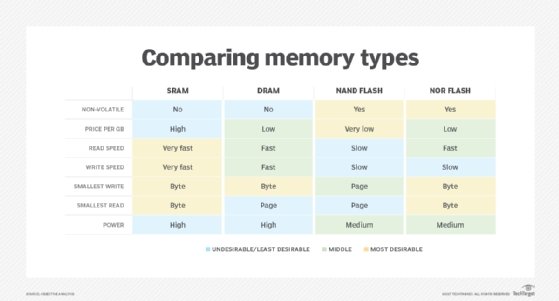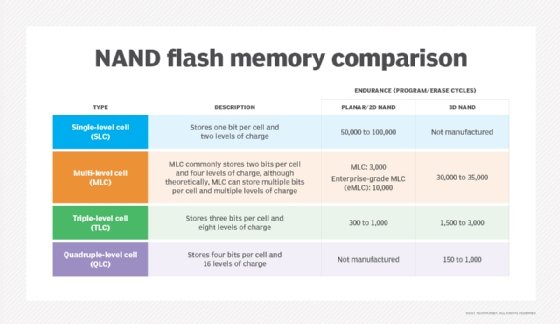
idspopd - Fotolia
NOR vs. NAND flash memory: What companies need to know
NOR and NAND flash memory each suit different use cases, and companies looking at a flash memory product need to know the difference before they buy.
Flash storage boils down to two basic choices: NOR vs. NAND flash memory. Selecting the right one for a particular application requires a solid understanding of each technology, including I/O performance, pin count, data integrity and longevity requirements.
"The application requirements will ultimately dictate the right solution," said Richard De Caro, NOR flash product line director for Micron Technology Inc.
When pondering NOR vs. NAND flash memory for a specific application, companies must also consider the product's interface -- SATA versus an embedded multimedia controller -- and density requirements -- solid-state drive versus a component package -- noted Scott Shadley, Micron's principal technologist.
"These [requirements] represent the highest level of differentiation of these two types of nonvolatile storage," he said.
The case for NOR vs. NAND flash memory
NOR flash offers faster read speed and random access capabilities than NAND flash memory, which makes the technology highly suitable for code storage in devices such as PDAs and mobile phones, observed Alex Lesser, executive vice president at supercomputing solutions provider PSSC Labs.
"[NOR is] not a good choice for high-performance computing solutions," Lesser said. "Also, NOR's write and erase functions are slow compared to NAND."
Using either NOR vs. NAND flash memory for general-purpose, storage-based applications is prohibitively expensive and generally leads to slow performance, said Richard Leonarz, Samsung's director of marketing for memory and storage.
"Anything beyond code storage is bound to create latency issues," he said.
Using NAND technology in code storage applications, on the other hand, would be costly and overkill.

There are two general categories of NOR flash: serial and parallel. They differ primarily in their memory interface design.
"Serial NOR flash, with its high-speed continuous read capabilities throughout the entire memory array, and its small erase block sizes, is tailored for applications that shadow program code and/or store granular data," De Caro said.
Serial NOR's low pin counts and small packaging make it a good fit for desktops; servers; and notebook PCs, Wi-Fi routers and printers, De Caro said. Serial NOR flash also often finds a home in Blu-ray players, wearables, smart meters and automotive advanced driver-assisted systems.
De Caro noted that parallel NOR flash delivers fast system boot times, which makes it ideal for high-performance applications and devices, such as digital still cameras, network routers and switches, home gateways, medical systems, and set-top boxes.
The case for NAND
The benefits of NAND flash memory include higher densities, sequential writes and faster erase times, Leonarz said.
"A drawback compared to NOR is that slower random access and byte programming is not supported, hence the need for garbage collection/trim," he said.
NAND is most commonly used in SSDs for consumer and enterprise PCs, servers, and notebooks.
"NAND solutions exist in removable media, as well," Shadley said. Various mobile platforms also take advantage of NAND, he added.
Lesser said that NAND is a good fit for data-intensive applications, such as SQL/NoSQL databases.
"Many of the new data center operating systems are leveraging the performance of SSDs," he explained.
Low-density NAND flash is a top choice for applications such as set-top boxes and digital televisions, whereas high-density NAND flash is most commonly used in data-heavy applications, including SSDs, tablets and USB flash drives, De Caro said.
NAND flash devices, available in 128 MB to 2 TB-plus densities, are used to store both data and code.
"There is a continuous effort to reduce the cost per gigabyte of NAND devices, so device lifecycles tend to be shorter with more frequent process lithography shrinks than NOR flash," Shadley stated.
NAND requires support from a controller, either internal or external, and specific firmware for error code correction, bad block management and wear leveling.
"There are two primary types of NAND: raw and managed," Shadley said.
Raw NAND comes in different flavors, including single-level cell, multi-level cell, triple-level cell (TLC) and, soon, quad-level cell (QLC). Additionally, NAND technology is migrating from planar to 3D architecture for higher density applications.

"3D NAND has an inherently larger cell with better reliability, so TLC based on 3D is expected to become mainstream in the next one to two years," Shadley said.
Raw NAND requires external management, but is the lowest cost per GB NAND flash available. Managed NAND incorporates memory management into the package, simplifying the design process.
The future of NOR vs. NAND flash memory
Shadley predicted that NAND will continue to evolve in 3D geometries over the next several years, continuing to offer higher capacity products with a lower cost per bit over time. He also expects to see new technology advances, such as QLC and application-aware storage, offered on top of NAND-based SSDs.
The outlook for NOR isn't nearly as bright.
"Big investment in NAND is helping to improve performance/endurance while reducing cost," Leonarz said.








